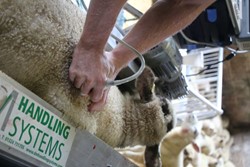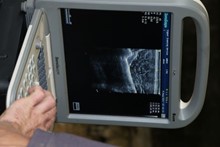Considerations when scanning

Considerations when scanning
Ultrasound scanning is an important service for those breeders wishing to enhance carcase quality through the use of muscle and fat depth EBVs.
When planning your scanning visit it is important to consider:
- The weight of the lambs you want to scan
- Whether your lambs have been treated with a pour-on blow fly treatment
- Whether lambs are going to be shorn or not prior to scanning
- How to deal with heavy lambs that will be sold prior to scanning
- If you are going to CT scan your lambs
If you have questions relating to any of these factors, please discuss them with your scanning technician when booking your visit. The timing of ultrasound scanning can be very flexible so you can fit the ultrasound scanning of your lambs in with the rest of your flock management. However, those terminal sire breeders looking to CT scan will need to bear the CT scanning schedule in mind when booking their ultrasound scanning appointment.
Scan Age
Ultrasound scanning your lambs will pick up the variation in your flock and the breed. To get the best results it is important that your lambs are big enough to show variation in both muscle and fat depth. To reflect performance at commercially relevant weights, aim to scan your lambs when they are around 40kg, ensuring the smallest are of 30kg. For lowland breeds this means you can certainly scan from 17 weeks of age, however for mountain breeds scanning over 20 weeks of age would be recommended and if probably necessary to pick up differences between breeding lines.
Blow Fly treatment
When there is a high risk of fly-strike, do not delay the treatment of your lambs with a pour on product. However, if you treat your lambs before a scanning visit, please make the technician aware so they can take the necessary precautions to protect themselves.
If you are using the opportunity of handling your lambs to treat them with a pour on product, please apply once scanning is complete and away from the scanner, not before or while lambs are in the scanning crate. Pour-ons are a major irritant to the face and hands of Signet technicians.

Shearing Lambs
When sheep have been shorn, the image quality can be reduced as the wool cannot be ‘parted’ to get the best contact between the skin and scanning head. This does not mean you should cancel shearing or scanning, but you may need consider the timing of each visit.
If you have or wish to shear your lambs before a scanning visit, please consider the difficulties that this may cause the scanner. Post shearing, scanning needs to be done 1-5 days after shearing (before too much regrowth) or 3 weeks post shearing (enough regrowth to split the wool). Please let your technician know when you plan on shearing your lambs, so they can plan accordingly.
Submitting scan weights for lambs that have been sold
If lambs have not been scanned you can enter a scan weight for these lambs. By going online and entering this data, you can provide additional scan weight records for any lambs that you have sold prior to scanning. If there has been several weeks between the original scan weight measurement and the on farm scanning, it may be advisable to assign these liveweight measurements to a new management group.
If you have any questions or queries please discuss them with your scanner when booking your visit or alternatively you can ring 07810 789501
About the author
Ed Brant
Ed joined the Signet team in September 2019, once he had got Kelso ram sales out of the way!
He has a degree in Agriculture from Newcastle University and a massive interest in genetics and performance recording.
The family farm in Lincolnshire has pedigree Hampshire Down and Lleyn flocks, as well as commercial sheep and cattle.



